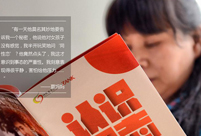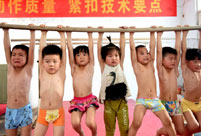 Happy life in Xinjiang
Happy life in Xinjiang
 2014 China Hainan Int'l Automotive Exhibition kicks off
2014 China Hainan Int'l Automotive Exhibition kicks off
 Collection of 'China Dream' public-spirited ads
Collection of 'China Dream' public-spirited ads
 The silent holy stones
The silent holy stones
 University students take care of giant pandas
University students take care of giant pandas
 Leading lady a true legend
Leading lady a true legend
 China Pan-Asia Stone Expo held in Kunming
China Pan-Asia Stone Expo held in Kunming
 Taiwan woman marries into Kazak family, 100 sheep plus a flat as dowry
Taiwan woman marries into Kazak family, 100 sheep plus a flat as dowry
 College girls take graduation photos under water in Chongqing
College girls take graduation photos under water in Chongqing
 Cartoon: Xi and football
Cartoon: Xi and football
Mini-stimulus to sustain stable growth for remainder of the year: economist
China saw its GDP growth tick up to 7.5 percent in the second quarter, a slight rebound from the first quarter's 7.4 percent growth, data released by the National Bureau of Statistics (NBS) on Wednesday showed.
Despite persistent downward pressure, economists believe the Chinese economy will continue to report stable growth in the second half of this year.
Citing stable data in prices, employment and income, Sheng Laiyun, a spokesman for the NBS, said at a press conference on Wednesday that "China's economic growth is stable and is within a reasonable range."
Premier Li Keqiang also said in a State Council meeting Wednesday that China must accomplish its major economic and social development targets, and reform will become one of the major forces driving that development.
The country's GDP growth hit 7.4 percent in the first quarter, the lowest level in five years. Since April, the government has rolled out a series of mini-stimulus and reform policies to stabilize the economy and boost growth.
Among other measures, the central bank announced two targeted reserve requirement ratio (RRR) cuts in April and June. Broadly speaking, RRR cuts are intended to boost economic activity by increasing the amount of cash banks have available to lend. in May, the country's top economic planning body, the National Development and Reform Commission, also announced 80 major investment projects in which the participation of private capital will be permitted, a move which experts say could also help inject vitality into the economy.
Economists believe that the recovery in GDP growth in the second quarter shows that these measures are having their intended effect, and will continue to benefit China's economy for the remainder of the year.

(Graphics: GT)
"China's GDP growth is expected to rebound to 7.6 percent in the third quarter and 7.7 percent in the fourth quarter, as the stimulus and reform measures continue to take effect," Xu Hongcai, director of the Department of Information under the China Center for International Economic Exchanges, told the Global Times.
Sheng, the NBS spokesman, also said that economic growth will continue to be stable in the second half.
China has set an annual GDP growth target of 7.5 percent for 2014. To meet the target, the government is expected to "continue its mini-stimulus program in the coming months," but the chance of a universal RRR cut and interest rate cut is quite small, Bank of America Merrill Lynch wrote in a research note.
Despite optimism about the second half figures, experts noted that downward pressure still remains, with the largest risks lying in the property sector.
Though real estate investment increased by 13.1 percent in real terms in the first half, sales of commercial property dropped 6.7 percent year-on-year in the period.
The floorspace of buildings newly under construction during the period also dropped 16.4 percent on a yearly basis, NBS data showed Wednesday.
More stimulus policies are expected in the property sector amid the downturn, Liu Dongliang, an economist at China Merchants Bank, said in a research note sent to the Global Times.
Several cities, including Nanchang in Jiangxi Province and Ji'nan in Shandong Province, have recently announced their intent to loosen property purchase restrictions, in a bid to alleviate further downward pressure on the market.
NBS data showed that growth in trade volume turned positive in the first half amid recovering external demand, especially in the US and Europe.
Total trade volume grew by a moderate 1.2 percent in the first half, compared with a 1 percent drop in the first quarter.
"But rising costs will be an uncertain factor in the export sector," Xu said, adding that how well the reform policies are executed will also affect future economic growth.
Sheng said that positive developments have already been noted in the campaign to shift China's economic growth from investment-led to consumer spending-led, one of the primary focuses of the Chinese government's efforts.
Consumption is playing a bigger role in driving China's economy. In the first half, consumption contributed 54.4 percent of GDP growth; fixed capital formation, a broad measure of investment spending, contributed 48.5 percent, while net exports contributed negative 2.9 percent, Sheng said.
 Moms on their kid’s coming out
Moms on their kid’s coming out Chinese fighters through lens
Chinese fighters through lens
 Children attend gymnastics training in summer
Children attend gymnastics training in summer
 Beautiful sceneries along the special travel route in Xinjiang
Beautiful sceneries along the special travel route in Xinjiang
 Beauty SWAT member in Xinjiang sparks online frenzy
Beauty SWAT member in Xinjiang sparks online frenzy
 Germany beat Argentina 1-0 to win World Cup
Germany beat Argentina 1-0 to win World Cup
 National fitness team members integrate traditional and modern beauty
National fitness team members integrate traditional and modern beauty Collection of 'China Dream' public-spirited ads
Collection of 'China Dream' public-spirited ads  How Chinese men kill the time when their wives practice square dancing?
How Chinese men kill the time when their wives practice square dancing? China's largest 3D printer builds 2-meter-long boat
China's largest 3D printer builds 2-meter-long boat
 One-legged women with high heel goes viral on Internet
One-legged women with high heel goes viral on Internet Photos of the Week
(July 6 - July 12)
Photos of the Week
(July 6 - July 12)
 'Super moon' seen in Beijing
'Super moon' seen in Beijing
 Happy life in Xinjiang
Happy life in Xinjiang
 'Finding Nemo' in Seattle Aquarium
'Finding Nemo' in Seattle AquariumDay|Week|Month